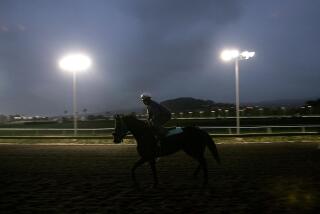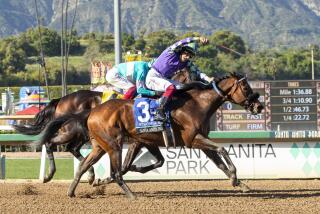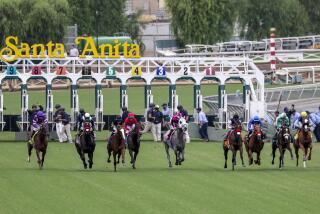Making Tracks to England’s Races
DORMAPS, England — The small cottage out of the 1700s was crouched at the foot of the hill--white-painted, stucco-sided, slate-roofed and cozy.
There was no town or village where the train had stopped after its one-hour trip south from London. All there was was a tunnel through which the train would continue on its way to the English Channel.
A country road ran across the tunnel and, from it, the cottage at the foot of the hill appeared to be alone. There were no other houses in sight.
Behind the cottage, in a field outlined by hedgerows, ducks waddled through clots of grassy mud.
Beyond that field lay another, this one containing two horses of the sort that deign to be saddled for casual canters down country lanes.
This was horse country.
This was why I had come, to visit a long-time friend from Philadelphia, married now for a decade and living in the country.
The cottage was hers.
During my London stay, I might have come down here any day. But this day came only once or twice a month.
It was steeplechase day.
I thought I would be going only to the races. Instead, it turned into a day in the countryside.
If I had wondered how the countryfolk spend a winter day, I found out. They spend it with boots on.
My friend pulled hers on and out we walked, across the neighbors’ muddy fields.
When we came in sight of the race course, it was like no race course that I had ever imagined.
It was countryside.
There were moats and hedges. There were fields as open as a lowlands golf course. There was a sloping hill off in the distance.
And, through it all, up onto the hill and back, there were fences, to guide the horses over hill and dale, fences so unassertive they might have been meant only to keep cattle away.
It was Lingfield Park.
It was a bit of an education.
Lingfield Park is one of 19 courses in the south of England, forming a circuit with such internationally famous courses as Ascot and Epsom (not Epsom Downs) and such lesser lights as Newton Abbot and Wincanton.
There is year-round racing at these places--flat racing at one meet and then, sometimes at the next meet and sometimes at the same course, a steeplechase over obstacles that the English call “flights.”
When and where can be discovered in a schedule for “racing fixtures,” meaning meets, at all 19 courses, which is available by writing to The Racecourse Assn., Winkfield Road, Ascot, Berkshire, SL5 7HX, England.
For example, next month there’s only one day of racing at Lingfield--April 7. In May, there will be three days of Lingfield racing--May 12, 19 and 26.
But if you have a taste for it, you can roam from track to track to catch the few races available in that still chilly month. In all the south of England in April, there are only five events.
Besides Lingfield on April 7, Folkestone, near the port of Dover, holds its only April race on April 2, Brighton holds its lone event on April 5 and April 6 is the day for two courses--Kempton Park, as well as Devon & Exeter.
Maybe that’s one of the lovely things about these tracks: Racing is such a seldom event, it feels like a surprise, a blessing.
And so for the admission price, which was the equivalent of $10, I got to stand in the cold, tramp through the mud and, in the end, enjoy it all.
Oh, gentle Lingfield.
No stands to sit in. Only a series of concrete steps where everybody stood, under an overhang.
No indoor betting booths and computers spitting out betting tickets.
Only legitimate bookies, more than a dozen of them, standing on little platforms in two neat rows, a few yards from the track railing, yelling out indecipherable odds and taking huge bets--I was startled at the 100 notes changing hands.
To get the feel of the course, my friend and I broke with the pack, ducked under the railing and headed out onto the course.
The length of two city blocks we walked, ducking under fencing a time or two, until we came upon what she called a “flight”--a broad hedge hiding a shallow pool--a water jump.
A little wooden bridge crossed the stream that fed the pool. And sitting on the bridge was a Land Rover, and inside a lady ready to act as a volunteer nurse and ambulance driver in case of nasty tumbles. The Land Rover was humming; at least she was keeping warm.
Two of my friend’s neighbors were at the bridge, the only other spectators besides us--the owners of a nearby farm, taking a day off and embarrassed for backing a growing list of losers that day.
There, too, was what we had come out for. The horses for the next race, milling about, the jump at their backs, the long straightaway toward the hill course lying in front of them and us.
You could hear the riders muttering to their mounts. You could hear them muttering to one another. You could sense the tenseness of the horses, being circled about tightly, to keep them on the move, ready.
Watch this, my friend said.
From a couple of tweedy fellows standing near the circling horses, track officials all, one broke off and walked a few paces ahead of the pack, took out what looked like a handkerchief and raised his arm.
The circle formed a line, a swaying, agitated line, prancing toward him, ever so slowly.
His arm dropped suddenly, without ceremony. It was as if he had decided to call everything off. It seemed to mean nothing.
It meant everything. They were off.
Mud flinging. The dull thunder remembered from movies--the earthquake rumble of a cavalry charge. And already, they were far down the grass straightaway.
The next race, they would be starting near the grandstand and running right past us, over the hedge and pool. We decided to stay put.
It was over. It had just begun.
The cost of admission varies slightly from course to course, the “racing fixtures” schedule says. There is the so-called club enclosure, “normally open to non-members who purchase a day badge--average price about $14 to $18 and at Lingfield that was a warm clubhouse looking out onto the course.
There is “the main enclosure . . . with access to the parade ring and unsaddling enclosure . . . average price $9 to $13.” At Lingfield, the enclosure was enclosed by nothing but railings and the frigid afternoon.
And then, God forbid, there are “enclosures” located further down the course (sometimes in the centre) . . . average price $4 to $6.” The English class system will never die.
More to Read
Sign up for The Wild
We’ll help you find the best places to hike, bike and run, as well as the perfect silent spots for meditation and yoga.
You may occasionally receive promotional content from the Los Angeles Times.






